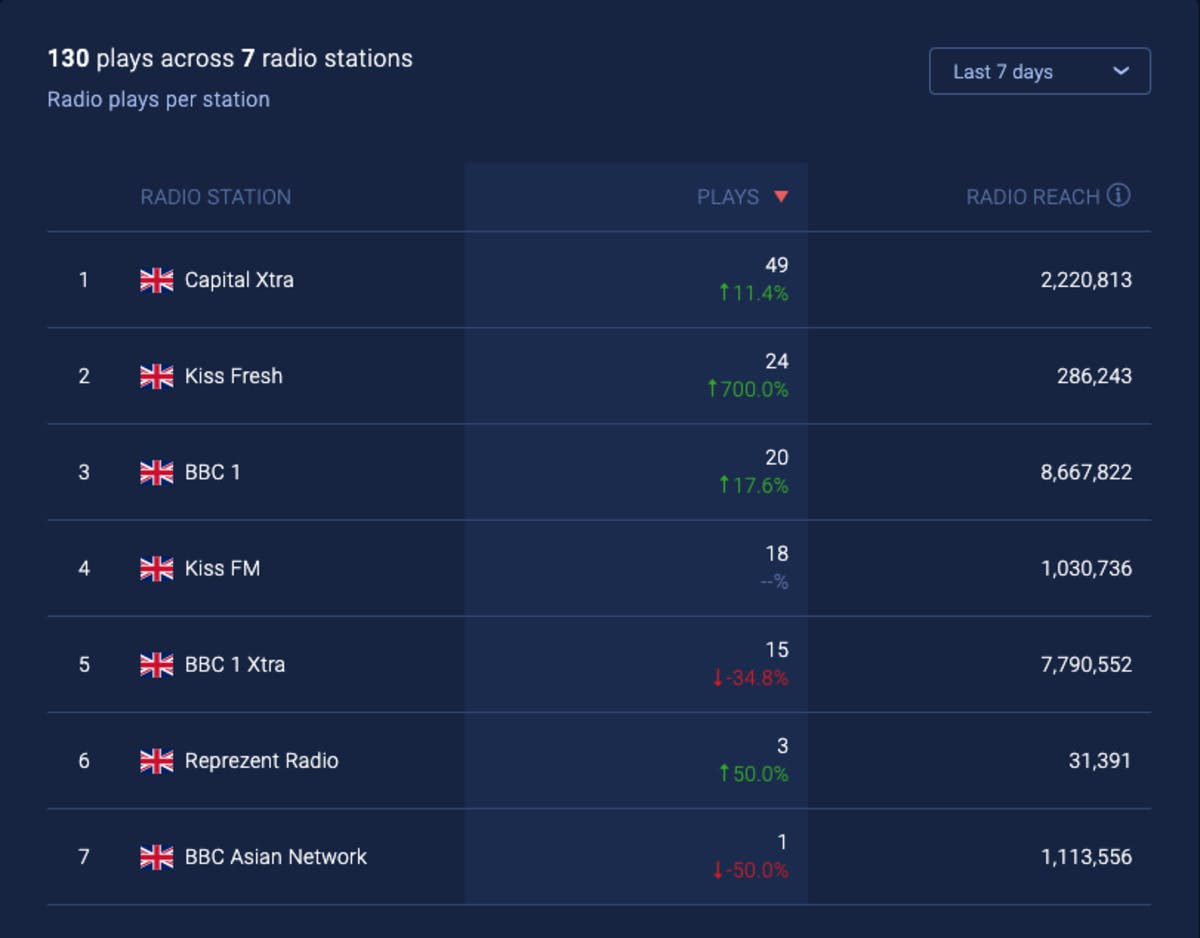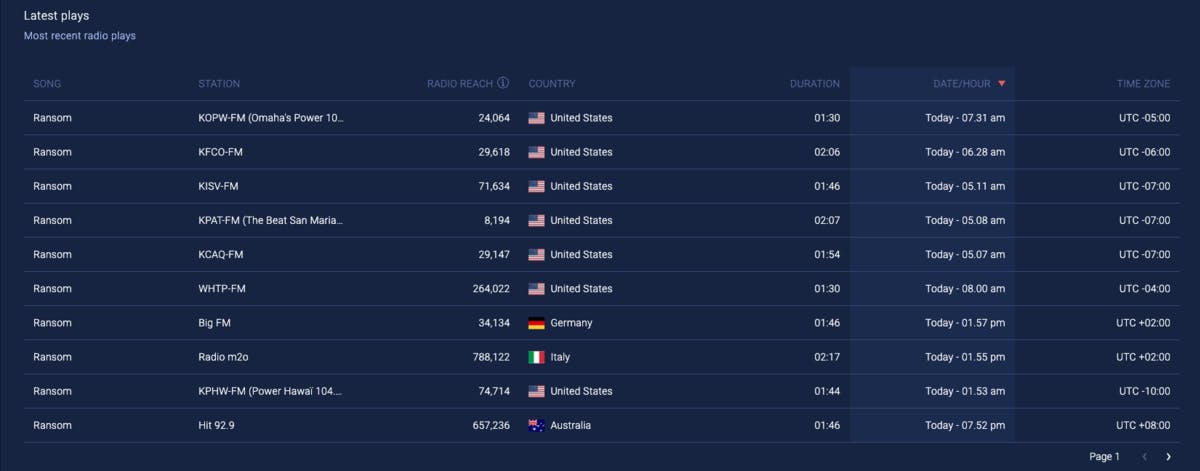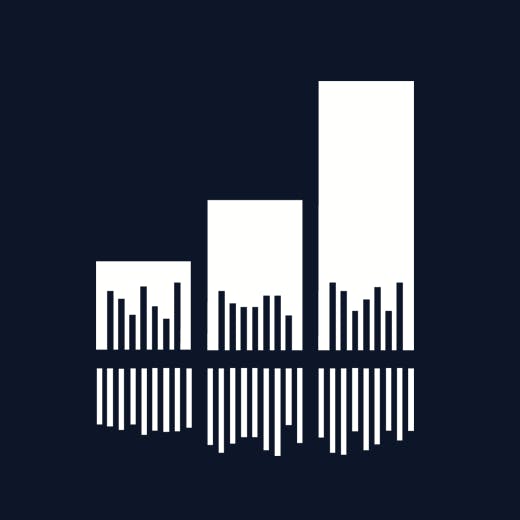Jump to
- Why You Should Track Radio Airplay
- 4 Criteria of a Useful Airplay Tracking Solution
- 1. Global Reach
- 2. Real-time Data
- 3. Artist-focused
- 4. Clean and Accurate
- Bonus: Complements Data From Other Channels
- 3 Ways Music Professionals Use Soundcharts Airplay Monitoring Data
- 1. Identifying High Potential Markets and Local Opportunities
- 2. Keeping Track of the Artist’s Radio Promotion Network
- 3. Claim Public Performance Royalties
- How Soundcharts Tracks Radio Airplay
Here’s how the music industry used to work: you developed your domestic market and then steadily moved into neighboring ones, broadening your reach and expanding your geographical presence. But times have changed. Rise of streaming services (and the digital environment in general) allowed music to transcend borders. Artists are no longer limited to their home regions; they can access markets and find audiences all over the globe.
However, each local music market is unique, and therefore requires a distinct approach to marketing, promotion, touring and so on. Mastering the landscape of different local markets requires investment, and even the best-funded artists are limited in how much they and their teams can invest.
In our open, digitally connected world, the challenge is to cut through the noise and identify the local growth opportunities and find the markets with the most potential for artist (or with the best ROI, if you will). That’s what makes radio airplay tracking a must-have tool for (almost) any music professional out there.
Why You Should Track Radio Airplay
Radio airplay is also the last major promotion/consumption channel that is locally based and closely tied to a region’s musical context. The radio airplay tracking data can provide invaluable insight into the local markets and help artists find opportunities all around the globe.
Besides, despite all the attention and excitement around streaming platforms, radio is still the primary source of music discovery for many listeners. In fact, in the US, weekly consumption via AM/FM radio is about 14 times bigger than aggregated weekly listening on all streaming platforms. You have to keep in mind the demographics of radio-listeners, of course — but you can’t ignore the medium that reaches 92% of Americans every week.
4 Criteria of a Useful Airplay Tracking Solution
There are quite a few airplay tracking tools available to music professionals. However, not all of them are created alike. Here are the must-have features that you should look for in an airplay tracker.
1. Global Reach
It’s not enough to track radio performance in the US and across Europe. Nowadays, your music can travel around the globe and find audiences you never imagined, so you need data that covers local markets all over the world.
2. Real-time Data
This data allows you to identify and capitalize on the opportunities before the moment has passed. If your latest single gets picked up on the radio in Italy, you need to know right away, so that you can get ahead of the curve and make the best use of the buzz, leveraging that momentum to grow the artist’s career.
3. Artist-focused
Tracking individual songs only gives you a partial view — tracking the entire artist’s catalog at once gives you insight on all potential opportunities. Of course, you can focus on your latest “radio single”, but consider this. Is it worth knowing that a major Indian radio station has been playing a song you released three years ago? Sure, the music business is a race — but that doesn’t mean that you have to wear blinkers.
4. Clean and Accurate
The music industry is plagued with metadata issues, and unreliable data is sometimes worse than no data at all. It can lead you to draw the wrong conclusions and make poor business decisions. You should trust the data you get.
Bonus: Complements Data From Other Channels
Radio airplay data is an important measure of an artist’s performance, but it’s far from the only one. Data from other channels like streaming services and social media puts radio play into a broader context and allows for a comprehensive view of an artist’s career.
Not to brag, but Soundcharts’ airplay tracking solution tics each of these boxes. We monitor over 1,700 radio stations all over the globe and organize that real-time data for you, turning it into actionable insights. Check it out for yourself: create your account for free is there for you if you want to see what you can learn from the airplay data on the artists you work with.
3 Ways Music Professionals Use Soundcharts Airplay Monitoring Data
Airplay monitoring can be useful in many ways. Here’s just a couple of examples of how professionals use Soundcharts’ airplay monitoring service to build and develop careers:
1. Identifying High Potential Markets and Local Opportunities
Record labels and music managers use radio analytics to highlight an artist's most active and fastest-growing regions. Soundcharts’ airplay heat-map provides a complete overview of the artist’s airplay presence across 68 local markets. This global view is complemented by a more detailed, customizable airplay chart that lets you dive into the data in each market.

Lil Tecca's "Ransom" is blowing up on the radio in the UK, the world's third biggest music market, adding up 42,9% in airplay since last week.
Music professionals use the airplay map to track the progression of an artist’s airplay presence over time. Detect high potential markets on the map, explore the airplay in that country in detail to verify the trend, and start working the market!
2. Keeping Track of the Artist’s Radio Promotion Network
Airplay doesn’t just happen. The song can get some organic radio buzz, but the long term success is a result of strategic approach and slowly building up an artist’s promotion network. Music professionals use Soundcharts to identify opportunities and measure success in this regard: tracking, maintaining, and growing artist’s airplay presence.

Based on per radio airplay data, we can assume that Lil Tecca was moved by programmers from BBC 1 Xtra and onto BBC 1, graduating into the country's mainstream
3. Claim Public Performance Royalties
Most radio stations outside of the United States pay out royalties to record labels and artists, as well as songwriters. However, you need the airplay data to claim these royalties. Performance Rights Organizations use Soundcharts’ to access real-time airplay logs and streamline the collection of global royalties on behalf of the artists.

The real-time log of latest broadcast detected by Soundcharts for Lil Tecca
How Soundcharts Tracks Radio Airplay
Soundcharts uses cutting-edge audio fingerprinting technology to ensure we detect and record every radio spin — even if the metadata provided by the radio station is corrupted. Our platform tracks over 1,900 major AM/FM radio stations and their playlists across 78 countries, and we’re always expanding our coverage based on the requests of the Soundcharts community.
- 396 US stations
- 935 European stations
- 644 stations from the rest of the world
But enough talking. Let’s see what Soundcharts airplay data can bring to you and your team.



